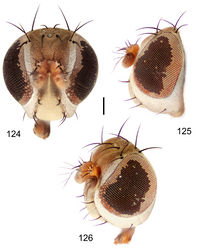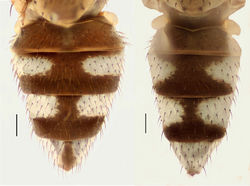Hydrochasma urnulum
| Notice: | This page is derived from the original publication listed below, whose author(s) should always be credited. Further contributors may edit and improve the content of this page and, consequently, need to be credited as well (see page history). Any assessment of factual correctness requires a careful review of the original article as well as of subsequent contributions.
If you are uncertain whether your planned contribution is correct or not, we suggest that you use the associated discussion page instead of editing the page directly. This page should be cited as follows (rationale):
Citation formats to copy and paste
BibTeX: @article{Mathis2013ZooKeys363, RIS/ Endnote: TY - JOUR Wikipedia/ Citizendium: <ref name="Mathis2013ZooKeys363">{{Citation See also the citation download page at the journal. |
Ordo: Diptera
Familia: Ephydridae
Genus: Hydrochasma
Name
Hydrochasma urnulum Mathis & Zatwarnicki, 2013 sp. n. – Wikispecies link – ZooBank link – Pensoft Profile
Diagnosis
This species is distinguished from other congeners by the following combination of characters: Small shore flies, body length 1.20–1.65 mm. Head: Antenna mostly dark gray; parafacial silvery white, concolorous with facial coloration; gena-to-eye ratio 0.14–0.16. Thorax: Wing with costal vein ratio 0.69–0.71; M vein ratio 0.53–0.55. Forecoxa mostly silvery gray to gray, with some yellowish coloration at ventral apex. Hind tibia with a small apicoventral seta. Abdomen: Tergites 3–4 with moderately deep, gray wedges along lateral margin of darkened coloration (Fig. 143). Male terminalia (Figs 127–130): Epandrium generally elongate, setulae moderately sparse though some elongate on dorsal portion, in posterior view (Fig. 127) with dorsal arch attenuate, not connected, dorsal half more or less rectangular, thereafter ventrally narrowed with ventral epandrial extensions narrowly developed, somewhat parallel sided to rectangular-shaped, slightly broader apex, in lateral view (Fig. 128) moderately elongate, anterior margin conspicuously sinuous, apex tapered, somewhat narrowly rounded; cerci short, length in lateral view (Fig. 127) slightly more than twice width, hemispherical; aedeagus in lateral view (Fig. 130) relatively simple, narrowly tubular, length 5× greatest width, shallowly curved subapically, in ventral view (Fig. 129) also tubular, narrow, elongate; phallapodeme in lateral view (Fig. 130) linear, elongate, very shallowly curved, extended keel narrow and short, as a slight bump, in ventral view (Fig. 83) T-shaped with crossbar at hypandrial end and gradually expanding toward aedeagal end, the end truncate; gonite in lateral view (Fig. 130) narrowly elongate, bar-like, more curved than phallapodeme, in ventral view (Fig. 129) narrowly bar-like, elongate, nearly straight; hypandrium in lateral view (Fig. 130) elongate, robustly narrow, length about 2/3 that of aedeagus, shallowly angulate, in ventral view (Fig. 129) elongate, U-shaped with anterior margin moderately narrowly rounded, lateral margins nearly parallel sided, posterior margin deeply incised, each arm tapered to narrow posterior process.
Type material
The holotype male of Hydrochasma urnulum is labeled “DOMINICAN RP. Puerto Plata (14 km E), R. Camu[,] 19°41.9'N, 70°37.5'W[,] 23May1998, WNMathis/USNM ENT 00088078 [plastic bar code label]/HOLOTYPE ♂ Hydrochasma urnulum Mathis & Zatwarnicki, USNM [red].” The holotype is double mounted (minuten in a block of plastic), is in excellent condition, and is deposited in the USNM. Fifteen paratypes (11♂, 4♀; USNM) bear the same label data as the holotype.
Type locality
Dominican Republic. Puerto Plata: Río Camu (14 km E Puerto Plata; 19°41.9'N, 70°37.5'W).
Other specimens examined
Neotropical. West Indies. COSTA RICA. Guanacaste: Bagaces Fortuna Z. P. Miravalles (10°43.1'N, 84°51.3'W; Sendero Cabro Muco; 980 m), 8–31 Jul 2002, J. D. Gutierrez (2♂, 4♀; INBio).
CUBA. Cienfuegos: Jardin Botánico (22°7.5'N, 80°19.2'W), 13 Dec 1994, W. N. Mathis (2♂; USNM). Sancti Spiritus: Topes de Collantes (21°54.4'N, 80°01.4'W; 670 m), 9–11 Dec 1994, W. N. Mathis (1♂, 2♀; USNM).
DOMINICAN REPUBLIC. La Vega: El Río (9.5 km E; 19°0.9'N, 70°33.5'W; 980 m), 6 May 1995, W. N. Mathis (1♂; USNM); Jarabacoa (1–2 km S; 19°06.9'N, 70°37'W; 520 m), 8–21 May 1995, W. N. Mathis (2♂, 5♀; USNM). Puerto Plata: Río Pérez (near Imbert; 19°44.1'N, 70°50.2'W), 24 May 1998, D. and W. N. Mathis (3♂; USNM).
JAMAICA. St. Thomas: Bath River, Bath (17°56.8'N, 76°21.6'W), 16 May 1996, D. and W. N. Mathis, H. B. Williams (3♂, 1♀; USNM).
PUERTO RICO. Adjuntas (18°09.8'N, 66°43.2'W), 22 Sep 1995, D. and W. N. Mathis (1♂; USNM); Maricao (18°11.1'N, 66°58.9'W), 21 Sep 1995, D. and W. N. Mathis (1♂; USNM).
Distribution
(Fig. 131). Neotropical: Costa Rica (Guanacaste), West Indies (Cuba, Dominican Republic, Jamaica, Puerto Rico).
Etymology
The species epithet, urnulum, is of Latin derivation and means urn, referring to the urn-shaped hypandrium in ventral view.
Remarks
Like Hydrochasma glochium, Hydrochasma urnulum has an expanded apical portion of the extended epandrial process but only slightly so (best seen in posterior view). The hypandrium of Hydrochasma urnulum is deeply and thinly V-shaped in ventral view with a distinct, U-shaped, posteromedial emargination (Fig. 129). In males of Hydrochasma glochium, the expanded apical portion of the epandrium is more pronounced (Fig. 86), and the hypandrium is V-shaped (Fig. 88) with each arm robustly developed.
Original Description
- Mathis, W; Zatwarnicki, T; 2013: A revision of the shore-fly genus Hydrochasma Hendel (Diptera, Ephydridae) ZooKeys, 363: 1-161. doi
Images
|
![Figures 81–84. Hydrochasma falcatum sp. n. (Peru. Madre de Dios: Río Manu, Erika) 81 epandrium and cerci, posterior view 82 same, lateral view 83 internal structures of male terminalia (aedeagus [shaded], phallapodeme, gonite, hypandrium), ventral view 84 same, lateral view. Scale bar = 0.1 mm.](https://species-id.net/o/thumb.php?f=ZooKeys-363-001-g032.jpg&width=167)
![Figures 86–89. Hydrochasma glochium sp. n. (Dominican Republic. Puerto Plata (14 km W), Rio Camu) 86 epandrium and cerci, posterior view 87 same, lateral view 88 internal structures of male terminalia (aedeagus [shaded], phallapodeme, gonite, hypandrium), ventral view 89 same, lateral view. Scale bar = 0.1 mm.](https://species-id.net/o/thumb.php?f=ZooKeys-363-001-g034.jpg&width=170)

![Figures 127–130. Hydrochasma urnulum sp. n. (Dominican Republic. Barahona: Baoruco - beach and river) 127 epandrium and cerci, posterior view 128 same, lateral view 129 internal structures of male terminalia (aedeagus [shaded], phallapodeme, gonite, hypandrium), ventral view 130 same, lateral view. Scale bar = 0.1 mm.](https://species-id.net/o/thumb.php?f=ZooKeys-363-001-g049.jpg&width=170)

